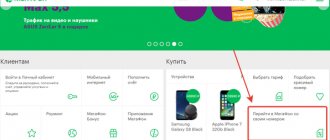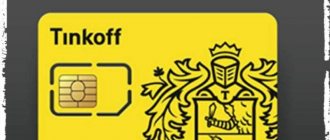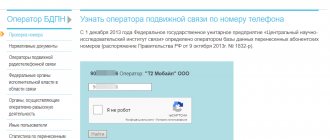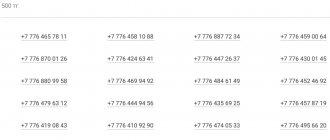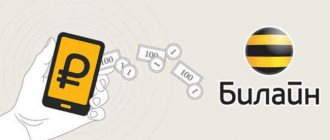Date: October 27, 2021 | Updated: April 9, 2021 | Author: Moblie-man
You may have already heard about the existence of such a technology as MNP, thanks to which today subscribers of any operator have the opportunity to switch to services from another cellular company while maintaining their old phone number.
And today we will look at the question of how you can switch to Beeline with your phone number, because this cellular company has been practicing a similar service for a long time and uses MNP technology.
How to switch to Beeline while keeping your old number
A subscriber who wants to change his current telecom operator to Beeline without losing his old subscriber number must:
- Visit any Beeline service office with your passport, or fill out an application for delivery of a SIM card by courier service,
- Make a written statement about your desire to transfer your current subscriber phone number to the Beeline network,
- After completing the application, select a convenient tariff plan, sign an agreement with Beeline and receive a SIM card.
Note! When filling out an application for transfer, the client can specify the date when it will be convenient for him to carry out the transfer - if such information is not specified by the subscriber, then the phone will be added to the Beeline network automatically after 8 days have passed from the date the subscriber signs the agreement with.
Until the process of transferring a mobile number is completed, the user will have two SIM cards in his hands: the old card of the previous provider with the old phone and the new Beeline card, which can be used and to which the new number will be linked until the actual number is transferred.
User reviews
Yulia “I recently found out that you can transfer your mobile phone from one operator to another, and decided to use the service. I liked the speed of the company’s work - within ten days I became a full-fledged subscriber. I would also like to note the fast delivery of the card by courier, which is very convenient for working people.”
Ilya “I decided to switch to a new operator because of the favorable prices and tariffs, but I really wanted to keep my mobile phone. It’s nice that the transfer option is free, you just need to fill out the information, sign the contract and wait for receipt.”
Online application to port a number to Beeline
Create an online application for number porting
It is not necessary to visit the office to switch to the ranks of clients of the mobile communication provider Beeline - you can switch to Beeline while saving your number online, using the operator’s official website, you just need to leave a contact number for consultation with the operator’s service specialist. What does the online application provide?
- Clarifying the transition details in a conversation with the operator,
- Delivery of a SIM card serviced by a temporary number
- Transfer and activation of the old number after 8 days to a new SIM.
Description of service
The cost is 100 rubles. The fee is charged one-time during number porting. Money is charged from the main balance on the third day after the operation. First you need to order a new SIM card. This can be done on the operator’s website, and the courier will deliver a new starter package to the specified address. After submitting an application for the transition, the operator dials the client to clarify the data and help in choosing a tariff.
You can select a tariff and options before going to the operator’s website. For convenience, you need to indicate your region at the top of the site and go to the tab with tariffs. Under each there is a detailed description with prices and conditions.
When filling out an application on the site, you must use the site menu, indicating your phone number. The subscriber is provided with a free temporary number, and 8 days after signing the contract it is replaced.
Conditions for porting a number to Beeline
Carrying out this operation requires the subscriber to comply with a certain number of conditions established by the Beeline operator:
- Submitting an application to connect the current subscriber number to a Beeline SIM can only be carried out by the owner of the phone if he has a passport, or a notarized power of attorney is required from the person who is the real owner of the SIM,
- The data specified in the agreement with the previous operator must be current, the subscriber number is not blocked and there are no debts on it,
- Only federal telephones (not landlines) located within one territorial subject of Russia are subject to transfer.
Important! During the process of transferring a subscriber's phone to a Beeline card, a short-term restriction on cellular services may be established - making outgoing calls and SMS is impossible for up to 30 minutes, receiving calls and SMS is impossible for up to 6 hours.
Connection and control
For control and transition you need:
- Go personally to any Beeline salon with a passport or order a card on the operator’s website. Leave a request to transfer your phone to Beeline.
- Choose a tariff, sign an agreement and receive a starter package, the price of which depends on the plan.
- The number is transferred within no more than 8 days from the date of signing the papers.
- Until the procedure is completely completed, new subscribers receive 2 SIM cards. The first refers to the old operator, on which the usual telephone combination is saved, the second - a Beeline card, on which there is a temporary number. It can be used until the transfer is complete.
- The old SIM card is deactivated, the temporary one is deleted from the second card and the transferred number starts working.
At each stage, the subscriber receives notifications via SMS. They are sent to both SIM cards, so new subscribers can easily control the progress of changing their phone number.
How to get more information on porting a number to Beeline
Need more information? There is a support service for subscribers by calling 8-800-700-4004. It is also possible to check the current processing status of an application submitted by a mobile communications user – *444*1#. Curious subscribers are invited to use the USSD command *444*interlocutor_number# to identify whether the phone belongs to the Beeline network.
It is easy to switch to Beeline while maintaining the old number of the previous operator; the company offers simple conditions for transferring a subscriber phone and consultation with specialists if necessary.
How does transferring a cell number to another operator work: FAQ and development experience
Let's start with the fact that now every cell number in our country has become significantly longer and begins, for example, on D7799
. D - this means that this 15-digit number cannot be dialed from a regular mobile phone. Then the area code (77), then the operator code (99).
CDB is a general database of Russian operators
When MNP (number portability) was just being implemented, the last three weeks were simply enchanting. Why? It’s just that throughout the world such a procedure is implemented on average in 2 years, but in Russia it was only 5 months.
Normal number porting process
There are 4 different transfer processes that differ in conditions and timing. They all imply that the subscriber comes to the recipient operator (from whom he wants to be serviced) and writes a transfer application indicating when he wants to switch.
With us, you can still make an application from the website from your personal account for both individuals and legal entities, so as not to fill out paperwork in the office. There is a courier who delivers everything at once along with SIM cards.
Immediately after the application we provide a temporary SIM card
(not all operators do this). During the first part of the number transfer, there is simply a random number on it from among the free ones from the number capacity, and after transferring your number to our number capacity, we simply rewrite the number on this SIM remotely. And the subscriber can safely call his old number without another trip to our office.
After you have submitted your application, we contact the central database through which all operators communicate. Communication goes like this: - Base, are we the only ones who are porting numbers now? — Yes, there are no two simultaneous processes. — Base, are the new number and the old number in the same subject of the Federation? — Yes, zonal addressing is the same. — Database, does the subscriber have any debt to the old operator at the time of submitting the application? - No, everything is clear, you can connect. - Database, just in case: is it exactly the number of this operator from which we are going to transfer? - Don’t worry, let’s bear it.
This is what it looks like for the subscriber.
After passing all possible status checks, the application goes to the donor operator for validation
(we call it “mother” in slang). Now the Big Three perform verification operations on individuals automatically, which saves a lot of time. Full name and passport details are checked. In our experience, approximately 30% of applications are eliminated at this stage.
If the validation of the questionnaire was successful, a pause is made for 2 days, the current debt is determined.
If it exists, another 3 days are given to repay it, during which the subscriber is told 2 times that he has not paid. Not repaid - the application is rejected. There is no debt - the transfer date is confirmed. There is an opportunity to refuse this transfer for 2 more days, then it will not be possible.
A day before the transfer, the subscriber receives an SMS with instructions that he must remember to change the SIM card and so on, while he can still receive them, because then the connection will be interrupted.
During the procedure, you can lively monitor the process. Here it is like this: • *444*1# - here is the command for the status of your application. • In the personal account of the temporary number - the status of the application and the progress of all procedures regarding it. • For every important event - an SMS with an explanation of what it means. • There is 8-800-700-4004 where you can call for the status of your application.
Point X
The transfer itself begins.
Interruption of communication for 6 hours is allowed by law. Here we have it: if all systems (ours and other operators) are working normally, then the subscriber is unavailable for about 20 minutes. More precisely, like this (the timing for us, for other operators will be different): • Outgoing communication is connected almost immediately. • Incoming Beeline - 15–20 minutes. • Incoming from the donor operator - within an hour, usually also 15–20 minutes. • Incoming calls from other mobile operators in the country - about 2 more hours. • Incoming from fixed-line operators - about the same, for rare regional operators - a little longer.
At moment X, when the transfer begins, a new number is written to the SIM card, and it is also updated in billing. It must be said that the SIM card contains only IMSI (International Mobile Subscriber Identity). Your IMSI is assigned a new Russian subscriber number.
In order to be able to define new routing, the entire addressing scheme in Russia had to be changed. As I said, numbers inside routing systems are now written in a 15-digit format starting with something like D7799. This means that now the ownership of a number is determined not by the first numbers like 903, as was the case when a specific number capacity was assigned to an operator, but by the region prefix and operator in this 15-digit “routing” number. Well, and also according to the “where to route” parameter, which may also be in the database (or may not be). This is important for clients of virtual operators.
After X
Payment systems receive information about the ported number and begin to correctly route payments.
Not everyone does this at the same speed, so a common request on the first day after the transfer is “When will my payment arrive?” On the first day, it is better to deposit directly through the new operator. It is optimal to pay by card from the new operator’s website or in the operator’s salon manually.
There may be cases when a subscriber begins to complain about a lack of communication in some areas. What is typical is incoming. And, naturally, he believes that the new operator is to blame.
In reality, everything is simpler. The fact is that with proper routing through the normal route, the call goes directly from the calling operator to the called operator without additional loops. If suddenly the caller’s operator switch decides that it is necessary to give the call to the “mother”, then the “mother” (as the original owner of the capacity) is obliged to route through herself. For money, by the way, which encourages many small operators to immediately register routes correctly. And of course, a regular problem arises: a subscriber comes to us, he does not have an incoming long-distance connection and part of the fixed line. The “mother” was unable to correctly forward the call to the routing node and hung up. This is due to inaccurate implementation of the specification on the nodes of the calling operator and, sometimes, to bugs in the routing of the “mother”.
Today, several thousand subscribers are transferred per day, and only 1-2 may encounter such problems. In the first 10 days or so after the start of the migration, we rolled out software releases every day, correcting both our own mistakes and achieving compatibility with the releases of our colleagues. We had to update 25 subsystems. It was decided this way: we immediately decided not to rewrite our standard CRM, but to make separate solutions that worked on the gap between the incoming data and the rest of the “internal kitchen”, and were responsible for converting numbers. A kind of universal connectors.
Number of transfers
The number of subscriber transitions from operator to operator is open data. On average, from the very beginning we have had a constant and large influx of legal entities, and in the last month there has been a stable plus for individual subscribers. At the beginning of MNP, we had a clear influx in the south of the Russian Federation and fluctuations back and forth in a number of regions, later the delta began to decrease, and now we are in a stable plus in terms of the subscriber base every day.
Other transfer procedures
For individuals the period is 9 days.
For legal entities, the period is 29 days, in particular, because manual verification of documents is mandatory. They also have an extended payment period; they can pay off the debt in weeks. You can indicate any number of numbers in the application, for example, only half of the corporate numbers from the entire contract with the old operator. Each number is transferred individually - at the end the statement is broken down into lines. For small legal entities with the number of numbers 5 or less - also 9 days.
For the B2G market (state-owned companies) - 9 days, but there is no debt verification. The contract is checked, when the competition is completed, it is verified that the person submitting the application is the winner of the competition.
There is also a procedure for emergency number return. For example, the subscriber changed his mind on time, took the application to the office at 21:59, but they did not have time to enter it into the database. In general, you can return the number back within 24 hours if there are compelling technical reasons. For example, one large plant was transferred from us, which suddenly changed its mind and wrote a letter of refusal. The operator he transferred to delayed the registration of the application, and the numbers changed. At this point, the employees had already thrown out the SIM cards of the failed new operator. And the next day after consideration of the claim, an emergency refund was made.
Increase your process: 10 times 25 centimeters
The length of the process with all steps in Visio is 250 centimeters.
We started with 4 steps, and then began to write exceptions. For example, the “nurse operator” has the right to say after 45 days that the subscriber owes him money. Firstly, a couple of rubles may come in after the last debt check. Secondly, there are a lot of details on postpaid, and the invoice may arrive in a month or two. Thirdly, late roaming data may only arrive. At this moment, the subscriber has 10 days to reach the old operator and pay off the debt (it won’t work through regular machines - the routes are already new). Further, if it does not extinguish, a block is placed through the central base (this is a mandatory condition of the standard). Several dozen numbers are blocked this way every day.
Another. Since at moment X the number moved from the “mother’s” number capacity to our number capacity, at the moment of the end of the contract we need to return the number to the base. Specifically, when the subscriber decides to end the contract, the number is returned. Now there are about 50–100 such returns per day.
FAQ
— Why can’t I transfer a number from one geographical area to another?
Because Russia uses a zone routing system. Abandoning such a system would mean restructuring the architecture of almost all fixed-line operators. But even if it is technically possible to register new routing in this way, legislative changes are needed - numbering capacity is now issued to the subject of the Federation.
— My girlfriend has free calls to Beeline, will she be able to call the new number for free?
Yes, when you transfer to us, the new number will be considered “ours”, and calls to her will be free. However, there is a nuance: when the “mother” or recipient is an MVNO without an MNC, then a special table of exceptions must be made. Not everyone does it, or some operators update it manually. This means, for example, that for a number of small regional operators the number may be “nobody’s”, and you will not be able to use bonuses for calling your own.
- How can I find out whose number it is then?
We have a USSD command: *444*NUMBER#, for example, 444*9031111111#. In response, a message comes with what kind of operator it is (Beeline or not) and what region (if it is different). Other operators have similar means (by calling on IVR or requesting via SMS or USSD), which should, according to the standard, give at least the operator. It is not necessary to give away the region, but we do.
— What should you check before transferring?
- Make sure that the “mother operator” has recorded your full name and passport data without errors.
- Check through the office of the “mother operator” or his call center that there are no debts of 2 kopecks on all old contracts. They will definitely remember the SIM card that you bought in another city 10 years ago and threw away at the station - pay an extra ruble to the cashier, or the “mother” will reject the application.
- If you go to a small regional operator or virtual operator, keep in mind that a lot can be registered there manually. You may not have a connection for 20 minutes, but a little more, plus there will be difficulties with billing and payment in the first days.
- If your phone is the only access to the Internet, write down the call center number of the new operator in advance - it will come in handy. All short numbering is routing within your operator's network. For example, we made aliases for “other people’s” short support numbers at home, but not everyone does this.
— Why were there so many errors in the first time after the introduction of MNP?
Colleagues will understand: we worked 15–17 hours a day back then due to very tight deadlines for specifications. Plus, naturally, few people outside the Big Three actually documented their technical processes in detail. As a result, for the first 4–5 months we caught bugs. It was not possible to test: all other operators immediately entered production, so the first 10 days (and about three to four hundred first subscribers) were actually beta testers. There were difficulties with encryption: each operator encrypts on its own side. The interaction took about a month to establish. Now we and other large operators have everything more or less debugged and automated, but out of two or three thousand subscribers, something will still go wrong with one. We'll sort it out with our colleagues, document it, and roll out a new patch.
— When are 100 rubles charged for transfer?
The amount specified in the regulations is charged for number transfer - 100 rubles. We write it off only when the transfer is successfully completed; some other operators take it upon submission of the application. This is important because from half to a third of applications are rejected, and these 100 rubles are not returned.
How long will the transition take?
In accordance with the law, the procedure until the number is transferred must be completed 8 days in advance . This is exactly the period of time it will take to verify and register your data at the Central Research Institute of Communications, which maintains a database of portable numbers.
During the transfer, you can use your number and receive information messages about the transfer process and the necessary actions on your part. The day before the end of the transition procedure, you will be sent an SMS notification about when you need to connect a new SIM from Beeline to your device. The old SIM will no longer register on the network and you will need to install a card issued by the new operator. If you do not specify other information in the contract, then on the eighth day after submitting the application the procedure will be completed.
How to change operator while keeping the number for legal entities? Legal entities and holders of corporate numbers are offered exactly the same procedure in which the number is preserved, but the law determines a longer period for transferring the number - up to 29 days .
What is the price
The cost of the number porting service is charged by the operator based on the subscriber service billing system you choose:
- 100 rubles for postpaid tariffs,
- 0 (zero) rub. when switching with the choice of a prepaid payment system.
The first way is to come to the salon in person
We choose a new operator and go to the appropriate mobile phone store or office - not the current operator, but the new one . That is, if you want to leave Beeline for Tele2, then we go to the Tele2 office, and not vice versa.
We tell the sales consultant that we want to write a transfer application. The employee will offer you a form that you will need to fill out, entering your current phone number and passport details. Next, the consultant will check your documents with the data specified in the form and start the transfer process.
How long does it take to port a number?
As a rule, the transition period is at least 8 days from the date of conclusion of the contract. In most cases, a new operator is hired exactly within this period. However, for some operators the transition may take longer, so it is best to clarify this issue with representatives of the specific company with which you are entering into an agreement.
It is also possible to set an individual transition date that you choose yourself. It should not exceed 180 days from the date of conclusion of the agreement.
Transition deadlines and information on maintaining your number
If you have chosen Beeline as the new operator of the mobile services you will be using, please accept our congratulations! As for the migration time frame, it will be
The time frame for changing your operator takes no more than 1 day from the moment you submit your application and receive the second SIM card.
Also, during the transition from one operator to another, there may be disruptions in the provision of communication services: the ability to make outgoing calls may be limited for 30 minutes, and the ability to receive calls is limited for a period of up to 6 hours.
Procedure for providing the service
How to change operator while keeping the number? In order to make the transition while maintaining the number to Beeline from MTS, Megafon, Tele2 or any other operator, you must personally come to any official Beeline representative office. There is no need to contact the company you decided to leave, and it doesn’t matter what your current tariff plan is. When visiting a Beeline office or salon, prepare and make sure of the following:
- The phone number to be transferred is registered to you personally. Otherwise, you must have a power of attorney for this from the owner of the number.
- By the time the number transfer is done, you should not have any debts to the previous operator for any of the numbers that are registered in your name.
- The previous porting of this number took place more than sixty days ago.
- Since MNP transfer can only be done within one region, you must contact this issue in the service area where you purchased the SIM card.
- Your number must not be blocked by the operator (debt, long-term non-use of the number).
- The passport data of the number owner at the time of the number transfer process corresponds to the passport data in the contract when purchasing the number from the previous company. There were no errors when filling out the data in the previous contract and the passport itself has not changed.
- Carefully read the new conditions and tariffs of the selected operator (this option is available in the company’s showrooms and on our website).
Important! There is one more limitation on the procedure for changing a telecom operator - you cannot transfer your “City Number” to another operator. This service is not legally established - only a federal duplicate of the “City Number” can be offered to you for transfer.
Waiting and replacing the card
According to the regulatory framework, in particular the previously mentioned Government Resolution No. 599, the process of number transfer cannot take more than 8 calendar days from the date of registration of the application. Naturally, this period can be extended by entering the required data into an official contract with the company. During this time, the subscriber can freely use his number in the existing network, and the technical card issued to him will not be active. More precisely, it can be used in the Beeline network using a temporary number, regardless of the main one (to be transferred).
At the set time, the SIM card operating in the previous network will no longer be registered, and its number must be linked to the new one. It should be inserted into your mobile phone and turned on. If the transfer process is canceled for any reason, then the next attempt will be given only after six months.
To prevent the subscriber from having unnecessary questions and misunderstandings, informational SMS with tips are sent to his number throughout the entire transition process. You can monitor the status on the operator’s official website using the USSD request *444*1# or a special verification service:
Alternative option
In contrast to the official version, there is another one that does not require changing networks, etc. To implement it, you need to purchase a Beeline SIM card with a tariff plan that suits the subscriber. Next, in the “Personal Account” service of the original operator, unconditional forwarding of incoming contacts for the new number is configured and the procedure can be considered complete. This option, at first glance, is much faster, it is less labor intensive and costly (the 100 ruble tariff is not paid). However, there are also pitfalls here, which consist in paying for each forwarding connection in the tariffs of the base operator.
See also the answers to questions about how old you can buy SIM cards, and what numbers Beeline numbers begin with.
Price
If you switch to Beeline with your own number, the cost can be zero when choosing a prepaid tariff, or only one hundred rubles if the tariff is postpaid. In addition, today, when switching to a prepaid tariff, the amount paid for the switch is returned to subscribers’ account in the form of bonuses.
As soon as bonuses from Beeline are credited to the client, an SMS notification is received, to which you need to send any response SMS to credit the bonuses directly to the client’s account. Bonuses can only be used to pay for various services from the Beeline cellular operator.
They can be spent on subscription fees, calls, SMS or MMS, while bonuses are never returned to the client in the form of real money, only as a discount on communication services.
A little about the procedure
The phone number portability service or MNP is not a new phenomenon. The first prerequisites for its implementation appeared precisely with the spread of mobile communications itself, somewhere at the turn of the 20th-21st centuries. Since the issue of ensuring healthy competition in the market has always been at the forefront, in Europe they began to implement it almost immediately. In Russia, the legislative framework was prepared at the end of 2013. At the same time, test transfers between operators began.
The difficulty with this procedure is to ensure the correct redirection (switching) of the call. Moreover, difficulties arise for both the operator and subscribers. In the first case, the problem is that numbers are allocated in large blocks, which simplifies switching, operator identification and billing (call costs). If any number from this block falls out, moving, for example, from MTS to Beeline, problems arise in the established switching algorithm.
For the subscriber, such a transition is inconvenient from the point of view that it is difficult to determine the operator, because the mobile network code remains the same. In this case, Beeline provides subscribers with the opportunity to check whether a number belongs to a specific network through a special service. You can use it on the company’s official website by following the link beeline.ru.
An alternative is to determine by sending a USSD request *444*9хх1234567#, where the “XX” characters represent the digits of the operator code in the subscriber number of interest.

